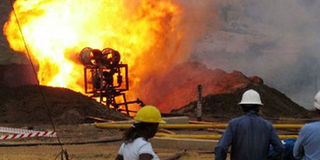Uganda signs off Shs4 trillion for US in refinery

Uganda signs off Shs4 trillion for US in refinery
What you need to know:
- Months earlier AGRC had been beaten to the deal by China’s Guangzhou DongSong Energy which scored 86 per cent during due diligence by a 10-member team drawn the ministries of Justice, Energy, Finance, Uganda Revenue Authority and UNOC.
- The proposed refinery is expected to have a capacity of 60,000 barrels per day (bpd) but construction is expected to start with capacity of 30,000bpd to allow operations to start.
US President Donald Trump’s principal voice on business Wilbur Ross has described the oil refinery agreement signed early last month with a consortium of American and Italian firms as a “major win for US commercial interests in Uganda”.
Mr Ross, the secretary of commerce, in a congratulatory message to the two American firms in the consortium—General Electric’s Baker Hughes and Washington DC based investment capital venture, Yaatra LLC, said the deal “embodies what we can achieve when government acts as a facilitator, not just as a regulator.”
The government on April 11 signed a project framework with the Albertine Graben Refinery Consortium (AGRC), a special vehicle of Italian and American firms, to design, finance, construct and maintain the proposed refinery in Hoima District.
The project is expected to cost Shs10 trillion ($2.85b) with approximately Shs4 trillion ($1b) in expected US export content, according to the US Department of Commerce, and create at least 5,000 jobs both in the US and Uganda.
Other firms part of AGRC are Italy’s Saipem SpA and Mauritius-based private equity fund Intra-continental Asset Holdings.
The refinery is expected to be financed in Public Private Partnership arrangement, with AGRC taking a 60 per cent stake, and government through the Uganda Refinery Holding Company, a subsidiary of Uganda National Oil Company (UNOC), taking 40 per cent.
Cost share
During their general meeting last November, UNOC shareholders, ministries of Energy and Finance, capped Uganda’s equity in the project at Shs2 trillion ($500m) in consideration of costs the government has already undertaken.
These include acquisition 29sq kilometres of land in Kabaale parish in Hoima—to accommodate the refinery complex and its attendant infrastructure such as staff quarters, chemical treating plants.
The refinery will be financed through a mix of debt and equity.
Kenya and Tanzania earlier offered to buy 2.5 per cent and Tanzania 8 per cent stakes, respectively in the project.
The refinery deal involved a lot of lobbying and the US Department of Commerce indicated that its advocacy centre, Mr Ross, US ambassador to Uganda Deborah Malac, and the US’ commercial service in Kenya, collaborated with Yaatra LLC since last year to secure the deal.
The AGRC was first announced winner of the refinery tender last year in August after a protracted inside battle between government officials and intense lobbying at the highest level.
Months earlier AGRC had been beaten to the deal by China’s Guangzhou DongSong Energy which scored 86 per cent during due diligence by a 10-member team drawn the ministries of Justice, Energy, Finance, Uganda Revenue Authority and UNOC.
The Department of Commerce said in May 3 statement that the refinery deal similarly has blessings of among others the US government’s Overseas Private Investment Corporation, the Trade and Development Agency: African Development Bank and World Bank.
The refinery deal, once successful, will be America’s biggest investment undertaking by far away from the traditional development assistance.
The success of American/Italian firms follows the 2016 exist of a Russian consortium RT Global Resources, which had been tapped as the most qualified lead investor during the first search for a lead investor.
However, sometime in 2015 the former US ambassador Scott DeLisi described the refinery deal to the Russians as “not a done deal” and warned that it could be problematic for Uganda because Rostec’s chief executive Sergei Chemezov was subject to US sanctions since 2014.
‘ATTRACTIVE’ DEAL
The proposed refinery is expected to have a capacity of 60,000 barrels per day (bpd) but construction is expected to start with capacity of 30,000bpd to allow operations to start. Uganda Refinery Holding Company general manager Michael Mugerwa described the internal rate of return on the project as “extremely attractive” given the amount of money (Shs6 trillion), Uganda spends on annual petroleum imports.




